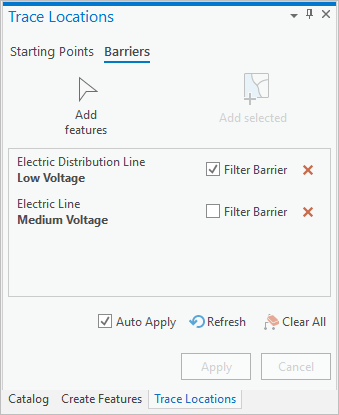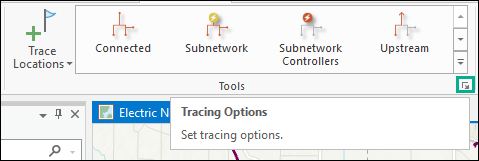All utility network traces require one or more starting points to define the starting location of a trace. Barriers are an optional component and represent a location in the network beyond which the trace cannot travel. To learn more, see Trace utility networks, Starting points, Barriers, and Trace results.
In the Trace Locations pane, two commands are available for setting starting points and barriers. You can use the Add features command  to manually select network features on your map, or you can click the Add selected command
to manually select network features on your map, or you can click the Add selected command  to set preselected network features in the map or attribute table as starting points or barriers. Starting points and barriers use a temporary feature class, named UN_Temp_Starting_Points or UN_Temp_Barriers, to store these features in the project's home geodatabase.
to set preselected network features in the map or attribute table as starting points or barriers. Starting points and barriers use a temporary feature class, named UN_Temp_Starting_Points or UN_Temp_Barriers, to store these features in the project's home geodatabase.

Requirements
The following requirements must be met to set starting points and barriers:
- Starting points and barriers must use utility network features.
- The network topology must be enabled.
Set starting points and barriers
Starting points and barriers can be set in the Trace Locations pane using one of the following workflows:
Starting points and barriers can also be set when working with spatial network features using the Add Trace Locations tool. This tool allows the selected network features or specified trace locations to be output to a feature class for use within a script or model. This can be useful to load the selection output of a trace operation as an input for a subsequent trace operation via a model.
Note:
Edge elements in the utility network support a single starting point and barrier. If more than one starting point and one barrier are specified for a network edge element, only the last starting point and barrier is honored, all others are ignored.
Add features by manually selecting in map view
This workflow demonstrates how to select network features on your map to set them as starting points or barriers. Follow this workflow if the features you want to set as trace locations are not already selected on the map. This workflow uses the default setting for the Trace Locations pane, with Auto Apply checked.
- On the Utility Network Data tab, in the Tools group, click Trace Locations to open the Trace Locations pane.
You can select the active tab that the pane opens with to be Starting Points
 or Barriers
or Barriers  .
. - In the Trace Locations pane, confirm the Starting Points or Barriers tab is active.
- In the Trace Locations pane, confirm Auto Apply is checked.
- With the Add features command
 active, click a network feature on the map.You can place a starting point or barrier on any network feature: a point feature, a specific terminal on a point feature, anywhere along a line feature, and on a polygon feature.
active, click a network feature on the map.You can place a starting point or barrier on any network feature: a point feature, a specific terminal on a point feature, anywhere along a line feature, and on a polygon feature.- A green circle is created where you clicked to represent a starting point.
- A red x is created where you clicked to represent a barrier.
Features are added to the Trace Locations pane and are ready to be used in a trace. For the Barriers tab, an optional Filter Barrier check box is displayed for each barrier. This allows the barrier to act like a filter barrier. To learn more, see Feature barriers.
See Work with features in the Trace Location pane to learn more about interacting with the starting points and barriers.
Add selected from the map view or attribute table
This workflow demonstrates how to set selected network features on the map or attribute table as starting points or barriers. Follow this workflow if you want to set trace locations using network features that are already selected on the map or if you want to add selected nonspatial edge or junction objects to serve as starting points or barriers. This workflow uses the Trace Locations pane, with Auto Apply unchecked.
- Select one or more network features on the map or attribute table that you will use as starting points or barriers.
- On the Utility Network Data tab, in the Tools group, click Trace Locations to open the Trace Locations pane.
Tip:
Use the Trace Locations drop-down arrow
 to select the active tab that the pane opens with: Starting Points
to select the active tab that the pane opens with: Starting Points  or Barriers
or Barriers  .
. - In the Trace Locations pane, confirm the Starting Points or Barriers tab is active.
- In the Trace Locations pane, ensure the Auto Apply check box is unchecked.
- In the Trace Locations pane, click Add selected.
The selected network features are added to the Trace Locations pane with an asterisk, indicating that they are not committed.
When trace locations are added from selected spatial features on the map or attribute table:- A gray circle is created where you clicked to represent a starting point.
- A gray x is created where you clicked to represent a barrier.
If you pass in a device or junction object with terminals, use the Terminal drop-down list to set the correct terminal as the starting point or barrier.
- Click Apply.
The gray icons in the map turn green for starting points and red for barriers, indicating that they are ready to be used by a trace. A temporary feature class is created in the project's home geodatabase, UN_Temp_Starting_Points for starting points and UN_Temp_Barriers for barriers.
Features are added to the Trace Locations pane and are ready to be used in a trace. .
Work with features in the Trace Locations pane
After features are added as starting points and barriers, they are populated in the Trace Locations pane. You can interact with these features directly to perform the following tasks:
- To place additional starting points or barriers, use Add Features to select network features in the map or use Add Selected to load selected features on the map or attribute table.
- To remove starting points or barriers, click the delete button
 next to each network feature in the pane, or click Clear All
next to each network feature in the pane, or click Clear All  to remove all features set as starting points or barriers.
to remove all features set as starting points or barriers. - For the Barriers tab, an optional Filter Barrier check box is displayed for each barrier. This allows the barrier to act like a filter barrier. To learn more, see Feature barriers.
- To interact with features in the map view, right-click and choose from the following context menu options:
- Flash

- Zoom To

- Pan To

- Pop-up

- Select

- Unselect

- Flash
- To interact with nonspatial features in the pane, right-click and choose from the following context menu options:
- Pop-up

- Select

- Unselect

- Pop-up
View tracing options
Options exist to control how trace locations are added to the Trace Locations pane. These options can be configured on the Tracing tab of the Network Options dialog box. To access these options, click the Tracing Options dialog box launcher  on the utility network's Data tab, at the lower right of the Tools group. This opens the Network Options dialog box with the Tracing tab active.
on the utility network's Data tab, at the lower right of the Tools group. This opens the Network Options dialog box with the Tracing tab active.

The Maximum number of starting points and barriers to add at once parameter governs the number of trace locations that can be created at a time without a prompt. The default setting of this parameter is 10. If more locations than this value are selected on the map or added from a selection to the Trace Locations pane, a dialog box appears, asking you to confirm that you want to proceed with the selected number of trace locations.